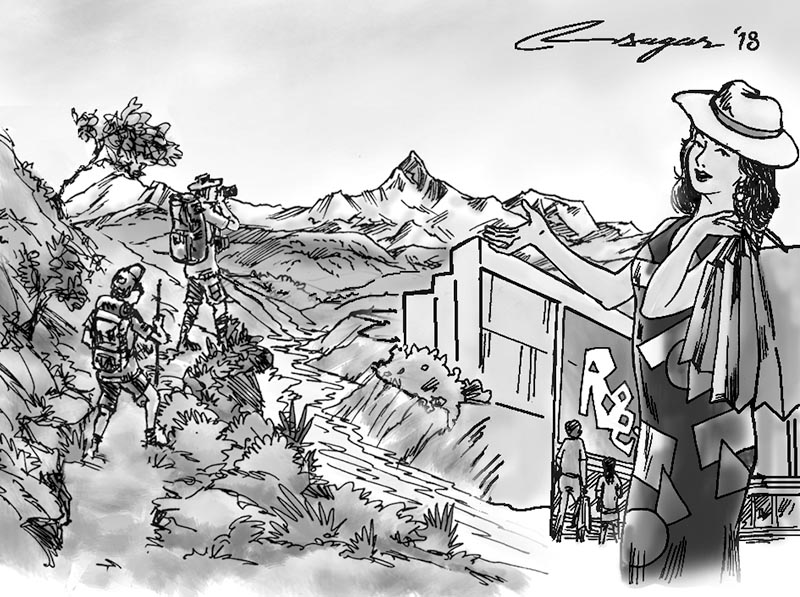Promoting tourism: We must broaden scope
Nepal is a multi-cultural, multi-ethnic, multi-religious and multi-lingual country. But the brand we have promoted to attract tourists largely focuses on limited aspects of tourism – nature, mountains, trekking and jungle safari to name a few
In more than 70 years of tourism development, we are still struggling to bring one million tourists despite the fact that we have numerous unparalleled tourism products and destinations. Why have we failed? What has paralysed our tourism sector? What are the impediments to development of tourism?
We adopted the brand “Naturally Nepal: Once is Not Enough” with an aim to promote Nepal and Nepali tourism internationally more than a decade ago. But the question is whether the brand we pitched truly represents Nepal abroad. What impression does the brand leave in tourists’ minds? Nepal is a multi-cultural, multi-ethnic, multi-religious and multi-lingual country. But the brand name for Nepal focuses on limited aspects of tourism – nature, mountains, trekking and jungle safari to name a few.
It seems we have yet to figure out our tourism products and destinations.
An Omani official once told me about Omanis’ priorities regarding holiday destinations. He told me Omanis choose holiday destinations in such a way that the entire family can have best of their times – entertainment and leisure, shopping experience, amusement for children and of course unique domestic products of the country they are visiting.
Compare this with our tourism products and activities. Except for some adventurous activities like trekking and sightseeing, our tourism products largely fail to captivate the imagination of tourists. This is the main drawback of Nepali tourism sector. We are largely confined to nature-based tourism and have put other potential sectors – culture, heritages and leisure activities – on the back burner. We have failed to develop new destinations and products in the last many years. Most of the organisations responsible for tourism development have been focusing mainly on mountain trekking and sightseeing.
Accessibility, accommodation and attraction are the basic components of tourism development. A single international airport, poor state of air network, bad roads and weak road networks are some serious impediments to tourism development. Tourists often face a hard time finding accommodation facilities when they are not in major cities. Trekking routes lack resting places. Good accommodation facility, tea houses (shops) and lookout points can certainly add value to trekking.
We often boast about the country’s natural attractions, but we have utterly failed to manage them form tourism point of view. For example, the Rara Lake is one of the most beautiful destinations, but where are the accommodation and other related facilities for tourists? What else a tourist can do after enjoying the beauty of the lake?
Legislation has entrusted the Nepal Tourism Board (NTB) with responsibilities of tourism product identification and development and infrastructure development. Tourism promotion in the international market is also one of the major tasks of the NTB. But it has largely failed to develop and manage tourism products. It is a simple notion that for a product to find a value in the market, it must be good.
Tourism is a cross-cutting sector hence concerted efforts from different stakeholders are required. Poor coordination among government departments and ministries has stymied the growth of the tourism sector.
The private sector has a crucial role to play in tourism governance. Be it product development or bringing tourists, the private sector needs to take the lead.
Traditional marketing strategies dominate the marketing of tourism products in Nepal. Participating in road shows, festivals and marts physically and distributing worthless poster and pamphlets are currently the priorities of the NTB.
Marketing strategies that were being employed before and since the inception of the NTB have failed to yield positive results. Despite this, the NTB seems to be least bothered about reviewing the present methodologies.
Lack of research, innovation and outreach strategies is one of the impediments to tourism promotion. We must put advertisements in popular international media to promote Nepali tourism internationally. Use of social media sites, interactive websites, mobilisation of NRNs and embassies are some of the tools to reach out to tourists.
I often compare Nepal with Jordan because both countries have two unique and unparalleled tourism products. Jordan has the lowest point on the earth (Dead Sea) whereas Nepal has the highest point in the earth (Mt Everest). Likewise, Jordan has an ancient city called Petra, which is recognised as one of the modern seven wonders; Nepal has the birth place of Lord Buddha, Lumbini. Around four million tourists visited Jordan in 2017 whereas in Nepal, the number fell short of reaching one million.
Similarly, a few days back I got an opportunity to visit Australia. I travelled to Sydney, Melbourne and Canberra. Interestingly, even though Australia has no unique tourism products and destinations, as many as 8.8 million tourists visited the country in 2017 -- more than one million in the month of December alone.
What do these cases suggest?
Clearly, well-managed tourism destinations with sufficient leisure components can attract tourists.
The government and the private sector must work in tandem to development Nepal as one of major tourist destinations.






